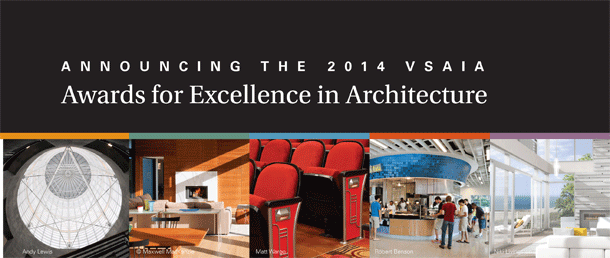Join the Virginia Society of the American Institute of Architects, the Virginia Center for Architecture, and Inform magazine in a celebration of the very best work from designers working from Virginia.
The Awards for Excellence in Architecture recognize outstanding design— both built and un-built — in five categories: Contextual Design, Residential Design, Architecture, Historic Preservation and Interior Design. All entries must be the work of architects who have an office in Virginia or are members (including associate members) of the Virginia Society AIA. The location of projects is not restricted, but built work must have been completed after Jan. 1, 2007. Un-built work will also be considered, as long as it was commissioned by a client as opposed to hypothetical work completed in the mode of research or academic training.
Awards certificates are presented each November at Architecture Exchange East, the Virginia Society’s annual conference. They are also honored during the Visions for Architecture gala, in Inform magazine, and serve as the subject of an annual exhibition at the Virginia Center for Architecture.
The 2014 Awards for Excellence in Architecture are sponsored by Hanbury Evans Wright Vlattas + Company, GeoEnvironmental Resources, and Jack Davis, FAIA.
DEADLINES
Entries: 5 p.m. on July 7, 2014
Project submissions: 5 p.m. on July 25, 2014
FEES
VS AIA Members: $190 first project; $160 each additional project
Non-member Architects (with an office in Va.): $245 first project; $215 each additional project
VSAIA Associate Members: $80 each project
CATEGORIES
[adrotate banner=”55″]Contextual Design
Buildings do not exist in isolation. The Award for Contextual Design recognizes outstanding architecture that perceptibly reflects the history, culture, and physical environment of the place in which it stands and that, in turn, contributes to the function, beauty, and meaning of its larger context. Evaluation criteria include:
- Does the design contribute to the fabric of the surrounding physical context through tangible qualities such as scale, form, materials, and architectural vocabulary?
- Does the design demonstrate an understanding of the history and culture of the place and embrace traditions relevant to its context?
- Does the design creatively embody the identity or mission of the client?
Requirements for submission should include a description of the context and how this context is reflected in the design, as well as images (photographs or drawings; at least two) that distinctly reveal the surrounding context of the project.
Residential Design
Aesthetic appeal and functionality are two long-established criteria for home design. More frequently, especially in the last several years, families have also been looking for affordability and resource efficiency. The jury will focus on the issues of:
- Design that suits the needs of the home owner or resident, regardless of any particular style, and is easily maintained, filled with adequate natural light and fresh air, energy and water efficient, and is universally accessible.
- Community building, in that the residence is well-sited with respect to views and amenities such as transit, shopping, recreation, and congregation.
Submissions should include a description of the sustainability and community-building programmatic aspects of the residence, interior and exterior photographs, plans, and/or drawings, and a site plan.
Architecture
Designers may submit projects of all types (including residential) for consideration in the Architecture category. In their deliberations, the jury will consider aesthetics, adherence to the client program, proven and projected building performance, and concept development. As with all categories, entrants will submit a project description and five pages of illustration, each of which may contain plans, sections, renderings, photographs, and captions, as the entrant deems suitable to describe the outstanding elements of the project.
Historic Preservation
The Historic Preservation category focuses specifically on excellence in strategies, tactics, and technologies that advance the art, craft, and science of preserving historically significant buildings and sites. The jury will also take into consideration adherence to local, state, and national criteria for historic preservation.
Interiors
Interior architecture projects of distinction will evince mastery of composition, functionality, material and color palettes, and well-integrated adherence to the highest levels of accessibility, health and safety, environmental, and occupant-comfort considerations, standards, and regulations. Submissions will highlight accommodation of project goals, including the client’s specific programmatic requirements, in a single page of text supplemented with five pages of illustrations in PDF format.
The Juries
The juries for each of the five categories comprise architects, educators, and related professionals working outside the mid-Atlantic region who are well-recognized for their work pertaining to their particular categories.

